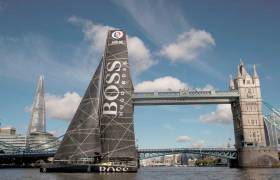Displaying items by tag: Vendée Globe 2020
Hugo Boss Backs Sailor Alex Thomson for Vendée Globe 2020
British sailing team, Alex Thomson Racing, that visited Irish shores this Summer today announced that their long-term sponsor, HUGO BOSS, has extended its partnership with the team for a further four years, in a deal that will take them through to the end of 2021.
HUGO BOSS has sponsored offshore solo sailor Thomson and his team since 2003 in what is one of the longest and most coveted partnerships in sailing. They will retain their title sponsorship rights meaning that Thomson’s IMOCA 60 racing yacht will continue to take the name of the upper premium fashion brand.
The renewed backing strengthens the Alex Thomson Racing team’s position as an early favourite for the Vendée Globe in 2020. The race, which has been in existence since 1989 and occurs every four years, sees sailors spend over 70 days at sea, has only ever been won by a French skipper. Thomson, who finished third in 2013 and second in 2017, will make sporting history if he wins the solo, non-stop, round the world race.
The Vendée Globe starts and finishes on the west coast of France. It is a 26,000 mile lap of the planet, non-stop, solo, and unassisted. With less than 100 people having ever completed the race, and only 50% of boats that start the race making it to the finish line, it is renowned as one of the world’s toughest, competitive sporting challenges. The race pushes sailors to the limit, both physically and mentally. In the 2016/17 edition, Thomson and Frenchman Armel Le’Cleach were in a constant battle for first place, neck and neck all the way to the finish line. Thomson finished just hours behind eventual winner Le’Cleach after 74 days at sea, breaking a world speed record in the process.
Alex Thomson Racing’s Cork Harbour based CEO Stewart Hosford said “We have a fantastic partnership with HUGO BOSS, and we are delighted to announce the continuation for the next four years. As a team we have set the benchmark for delivering value as one of the world’s leading sailing teams; we work hard to ensure we win on the water and deliver value and return off the water. With our strategy and objectives clear, and the continued relationship with HUGO BOSS confirmed, we are in a good position to focus on 2020 and there remains an opportunity for additional partners to join the team. Our values are closely linked with those of our sponsors and many global brands.”
Looking forward to 2020, and with his sights set firmly on the bringing home the gold, Thomson said; “I am looking forward to another successful cycle, with the focus on building the best team, boat and campaign for the Vendée Globe in 2020. As our main sponsor, HUGO BOSS have supported the team and enabled us to push boundaries and innovate both in our approach to sailing and the ways in which we share our sport with our audience. I very much look forward to building on the successes we have achieved and working together over the next four years.”
Mark Langer, CEO HUGO BOSS AG, added: “Alex Thomson is an outstanding sportsman and for us a great brand ambassador. Together with him and his team we can look back on many incredible moments both on and off the water. We are delighted to continue our successful partnership.”





























































